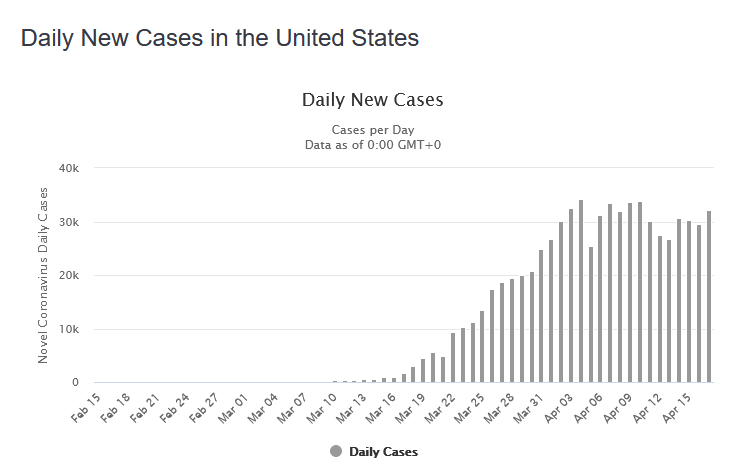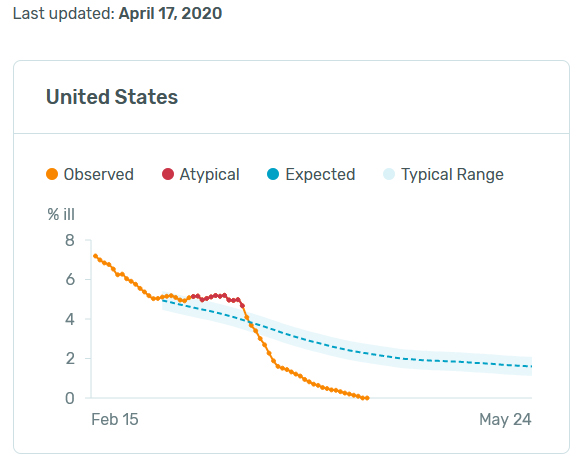It’s been two weeks since my last writing on COVID-19. At that time, I predicted that based on looking at trends in Italy and other European countries, the number of new cases would stop rising in the next seven days. That happened, with the highest total recorded on April 4. I also predicted that cases would begin to drop after the peak, and so far that has not occurred. The number of daily new cases and daily deaths from COVID-19 in the United States has reached a plateau with no clear sign of a downward trend.

The original models that charted exponential growth and two million deaths were wrong, as we quickly realized once social distancing began to take effect. And the oft-cited IHME model, with it’s bell-shaped peak, is also proving to be incorrect.
What is going on?
The plateau seems to be driven by two factors. The first is that testing is increasing and flu season is ending, meaning that a greater proportion of people with flu-like symptoms now have COVID-19 and we are detecting a higher proportion of total cases. In places where other measurements like hospital admissions are in decline, it is likely that actual new cases are in decline as well. That would be good news.
However, we are not seeing fewer people dying yet, and we are now beyond the time window within which the effects of social distancing should be evident, so something else is going on. Nationwide, fevers – as reported by smart thermometers – have declined to historic lows of effectively zero

The surge in “atypical illness” – likely COVID-19 – that began in early March has rapidly receded, and fevers quickly dropped below the expected flu-season range and then gradually to zero in the course of less than a month. This is solid evidence that social distancing is effective.
But how can this be reconciled with the reality that there are presently at least 100,000 people sick and feverish with COVID-19 in the United States? The unfortunate answer, I believe, is that we have not reduced R regionally, but rather demographically. Administrators, IT professionals, professors, office workers – the people who live in smart homes and own smart thermometers – have been safely working from home. Their only risk of exposure is from a weekly trip to the store and passing mostly-healthy neighbors on walking paths, and so R for them has dropped to well below 1, maybe even 0.1 or 0.2.
On the other hand, grocery store cashiers, care home nurses, bus drivers, farmworkers, and food industry workers have continued to breathe the same air as hundreds of other humans each day. Their jobs can’t be done from home, and they are not optional. Even if these people could afford to miss work – which many of them can’t – our society would suffer a far greater loss of life if we stopped tending the sick, producing food, and maintaining basic services. So it is that we are seeing the worst outbreaks in places like the Smithfield pork facility and vastly disproportionate infection rates among black and latinx communities who are also disproportionately employed in essential but underpaid and underappreciated work. For these groups, R remains elevated, probably still above 1 in many cases. The plateau in case counts, in other words, may represent the balance between dramatically decreasing infection rates among privileged classes and stable to increasing infection rates among essential workers.
When can we reopen?
The trillion-dollar question these days has become a political football, and as with all political divisions the rhetoric on both sides has become warped from reality.
The choices ahead of us will not be easy. There is no win-win. It will be a compromise of lose-a-little-lose-a-little. On the one hand, relaxing restrictions will lead to increased illness and death. In most places it should not be difficult to achieve the objective of remaining within the capacity of the healthcare system, but within that there is still plenty of room for suffering and loss of life. On the other hand, maintaining restrictions will lead to loss of livelihood. The longer restaurants and shops remain shut, the fewer will be able to reopen. Loss of livelihood leads to depression, anxiety, addiction, food insecurity, and homelessness – all of which can lead to illness and death in their own way.
We absolutely need to increase our testing game, and provide adequate PPE to our healthcare workers. I am befuddled that we are still so far behind this far into the pandemic, and I hope that we can begin to catch up in the weeks ahead.
That aside, I do not believe it is premature to talk about reopening, or to consider what steps might alleviate economic pain without greatly increasing infection rates. After all, the restrictions were put in place in panic mode, in a state of emergency, without a clear understanding of which ones are really effective and which are less consequential.
We also need to improve our empathy and relax our desires to police each other. From the perspective of a work-from-home administrator, any social gatherings seem irresponsible. From the perspective of a bus driver, breathing community air all day long, being reprimanded for having a beer with friends after work seems draconian and out-of-touch.
I ask that we resist the temptation to speak and write in terms of unfair equivalencies. Stay-home orders are not the government attempting to control a herd of sheeple. Nor is it fair to portray the decision to reopen as grandma’s life versus Goldman Sachs executive bonuses. The reality is more like a modest increase in grandma’s chance of dying versus grandma being isolated from family for many months during which time she may die anyway. It is, for many furloughed workers nearing retirement, a choice between risking death now and retiring in a few years, versus losing employer-sponsored health coverage, racking up medical and other debts, and being forced to work for additional years if they can even get their jobs back.
Trump is the wrong leader for this time, because he always needs to fight for a side, and he keeps switching sides. Blame China! We’re doing great! We’re failing! But it’ll be over soon! Oh crap the models say we’re all gonna die! Stay home! But the economy is crashing, liberate! Liberate! In that way he is going through the same emotional cycles that the rest of us are, and while many folks find that relatable it is not effective leadership.
Effective leadership requires listening and compromise. We need to listen to all sides and all perspectives. We need to scale back restrictions slowly and intelligently, starting with steps that maximize job recovery with minimal added risk of infection. We need to protect our essential workers, by all wearing masks where social distancing isn’t possible. We need to ramp up testing, start testing for antibodies, and trace contacts, so that we can replace social distancing with less disruptive ways of reducing R.
I will make no strong predictions as to where we will be in another two weeks, although I would expect case counts to begin a noticeable decline and most less-affected regions to make tentative steps toward reopening. We shall see – as usual models are wrong, reality is messy, and the truth is in the middle.
